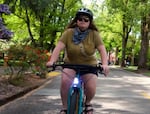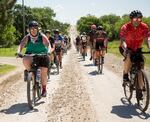Imagine this: you’re browsing through your social media feed and come across a striking photo of someone standing astride their bicycle, arms raised in celebration against the background of a snow-capped mountain or a monster gush of ocean spray.
“One of the ways I got into biking was seeing photos of people that looked really cool in a really amazing place,” remembers Kailey Kornhauser, an avid cyclist and forestry Ph.D. candidate at Oregon State University.
Social media has inspired lots of us to get outdoors and be more active. But if you pictured the triumphant cyclist above as a fit, white man in spandex, you’re not alone.
“There were no fat people. There were also no people of color, there were no queer people. It was really the, you know, straight, smaller-bodied, white men that I was looking at and aspiring to be,” Kornhauser recalls. “Now there are just so many more people you can aspire to be!”
That shift is due in no small part to her own efforts.

Oregon State University doctoral candidate Kailey Kornhauser rides through the Corvallis campus.
Todd Sonflieth / OPB
A self-described “fat woman,” Kornhauser got into cycling when she started college and didn’t have a car. It was a great way to get around, but she found herself struggling with some other barriers.
“I was friends with a lot of people who rode bikes and they all looked a certain way and they all rode bikes a certain way, and I thought that I had to look like them and bike like them to be a biker, like, to be a cyclist,” she said. “And so, for a long time I thought that biking was going to help me lose weight, and I approached it as a form of exercise that I hoped would result in me becoming a smaller person. But that never really happened.”
Kornhauser felt that familiar frustration until she began seeing social media groups such as Unlikely Hikers and Fat Girls Hiking that celebrated the joys of outdoor adventure without the strictures of what it had to look like.
Those Pacific Northwest-based groups helped reframe Kornhauser’s approach to cycling from a way to change her body to something she simply liked doing.
Kornhauser began bike packing long distances. Several 500-mile treks in 2016 and 2017 prepared her for a 1,000-mile bike-packing trip across Alaska in 2018. Writing about her experiences on social media attracted supportive followers, and in February 2020, just before the pandemic hit North America, Kornhauser was featured on the cover of Bicycling magazine with the headline: “Every body is a cycling body.”
“From the moment I started writing about myself as a fat person, something changed in me, and people really resonated with it,” she said.
One of the folks it resonated with was Marley Blonsky, then a sustainability director at a Fortune 500 company in Seattle. What other groups had done to promote inclusion in hiking, the partnership of Kornhauser and Blonsky did for cycling with All Bodies on Bikes.
The group quickly built a loyal following and began leading rides, sharing route experiences and conducting workshops centered around how to be a plus-sized cyclist.
In spring of 2021, the duo starred in an eponymous short documentary directed by adventure filmmaker Zeppelin Zeerip and sponsored by Shimano, an international bike parts manufacturer. The film went on to win the Best Documentary Film prize at the Oregon Short Film Festival and has logged some 275,000 views to date. It also boosted Blonsky and Kornhauser’s profiles as influencers.

Marley Blonsky, left, and Kailey Kornhauser of All Bodies on Bikes take a selfie at Frog Lake near Mount Hood. The popularity of their group has made them social media influencers.
Todd Sonflieth
“Oh man, we did not set out to be influencers,” laughs Blonsky in an unguarded moment of self-consciousness. But six months ago, the group’s success allowed Blonsky to quit her corporate job and concentrate on All Bodies on Bikes full-time.
“A big part of being an influencer is just sharing our experiences,” Blonsky said. “So, brands pay me and give us product to then promote on our social media channels.”
Blonsky approaches the advantages as well as the responsibilities of the group’s profile with deliberation and intention.
“I only partner with companies that I know,” she said. “But also, they need to hold the same values that I hold. I get companies asking me to promote their product or be an ambassador, and I’m like, ‘You don’t even make an extra-large. Why would I promote you?’ And I’m always trying to push those brands to do more and to be more inclusive.”
Blonsky characterizes the group’s social media growth as “meteoric,” attracting more than 10,000 followers on Instagram and 3,000 on Facebook.

Marley Blonsky, left, leads a group ride during the 2021 Unbound Gravel event in Emporia, Kansas.
Linda Guerrette
But according to Blonsky, the biggest growth has come from the biking world itself. Along with new industry partnerships, this year All Bodies on Bikes members will attend some of the biggest organized races, including Unbound Gravel and SBT GRVL.
Recently, Blonksy and Kornhauser were invited to the UCI Cyclocross World Championships in Arkansas, where they led a group ride and sat on an advocacy panel. At that event, they felt like celebrities.
“No joke, we couldn’t go five minutes without somebody recognizing us and asking for a photo or wanting to talk,” Blonsky recalls. “This really just feels like a wild ride.”
Kornhauser compares her life now to living a dream.
“I had for so long felt ashamed about my body size or something I was trying to change about myself,” she said. “But it’s definitely solidified in my head like, ‘Okay, that was the right thing to start loving myself and accepting myself,’ because it turns out a lot of people like this version of me better than the one who was trying to make myself smaller, you know?”
Related: Unlikely Hikers: A Hiking Group for the Rest of Us
